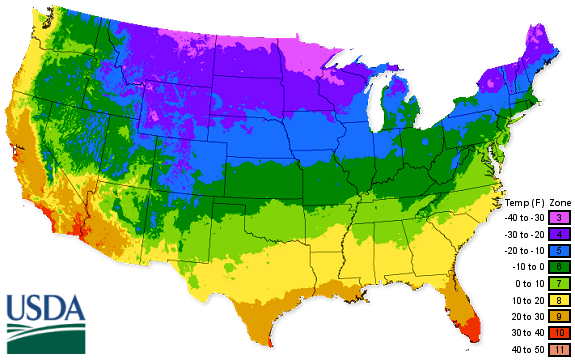What is My Growing Zone?
Knowing your growing zone is probably one of the most important pieces of knowledge in gardening. Plants are often referred to as hardy to a particular zone. This means that they can survive in the lowest winter temperatures of that zone. You always want to choose plants that are recommended for your particular growing zone. This is a great way to get started on a planting path to success!


-

Zone 3
Zone 3 is the coldest of all the planting zones in the U.S. This zone has the shortest growing time for gardening. If you start seeds indoors as early as March or April and then transplant them outside after the last frost date you can have success with hot weather vegetables. You can grow almost everything inside as long as you grow them in a sunny spot.
Zone 3 hardiness dates are: Last Frost Date - May 15 and the First Frost Date is September 15.
-

Zone 4
Generally in zone 4 you should not plant outdoors until around May 15th. Always pay attention to frost and cover plants as needed. Start the seeds inside near a sunny spot. You can grow more frequently inside in one of our grow bags.
Zone 4 hardiness dates are: Last Frost Date - June 1 and the First Frost Date is October 1.
-

Zone 5
When planting outside, zone 5 is a medium length growing season. Use your last and first frost dates to determine your planting schedules. Using the planting schedule above you will get the most out of your outside garden. You can grow continuously inside in our grow bags.
Zone 5 hardiness dates are: Last Frost Date - May 15 and the First Frost Date is October 15.
-

Zone 6
Zone 6 has a medium length growing season. Most plants will have no problem maturing before your first frost date. In general the information listed on your seed packet will be the most accurate information.
Zone 6 hardiness dates are: Last Frost Date - May 1 and the First Frost Date is November 1.
-

Zone 7
Zone 7 is also a medium length growing season. You should have around 7 months gardening time outside. Cool weather vegetables can usually be planted outdoors in early February. These crops include beets, broccoli, cabbage, carrots, lettuce, onions, peas, potatoes, radishes, spinach, turnips, kale and collards.
Zone 7 hardiness dates are: Last Frost Date - April 15 and the First Frost Date is November 15.
-

Zone 8
Zone 8 has a long growing season with hot summers. Most vegetables will have no problem maturing before the first frost date. Zone 8 follows the same schedule as zone 7 but can plant two to three weeks earlier in the spring and two to three weeks later in the fall.
Zone 8 hardiness dates are: Last Frost Date - April 1 and the First Frost Date is December 1.
Zones
-

Zone 9
Zone 9 has a long growing season and most vegetables will easily mature before your first frost date. Most cool weather crops can be planted just once per year because they hate the heat. Fast maturing plants such as cilantro or lettuce can be planted twice (in August or September and again in January or February). This zone requires more water, more frequently.
Zone 9 hardiness dates are: Last Frost Date - March 1 and the First Frost Date is December 15.
-

Zone 10
Zone 10 has a long growing time for gardening outside. In hot climates, organic matter decomposes much more quickly than it does in cool climates. Mix lots of compost into the soil at planting time. Compost improves the soil’s moisture retaining capacity acting like a sponge to hold water until our plants need it.
Zone 10 hardiness dates are: Last Frost Date - January 30th and the First Frost Date is December 30th.

Separated by 10-degree differences, hardiness zones run from the lowest to highest possible cold conditions. Vegetation with the lowest numbers can withstand the coldest weather, while higher numbers mean warmer climates are a better match when growing outside. Plants that belong to hardiness zones three to seven are hardy enough to survive some cold, but not enough to endure extreme and prolonged icy periods. Three to seven zone plants need a certain amount of cold and will likely perish in the desert heat.
There are also climate conditions in your area which will affect which types of plants will do well.
Winds - Winds dry out vegetation and high winds can damage plants. If you live in a windy climate, be sure to select stronger, low lying plants.
Urban Heat - Metropolitan areas are generally warmer than rural areas even if they are in the same zone. Urban environments absorb and trap heat with all the concrete and maintain higher year round temperatures.
Rainfall - The soil will be much moister with greater rainfall. The Pacific Northwest need to choose wet tolerant plants or improve their soil drainage, whereas gardeners in dryer areas won’t be concerned about rainfall.
Humidity - California and Florida have parts of their states with the same hardiness zones but their relative humidity levels are vastly different. High humidity slows down a plant’s transpiration rate.
